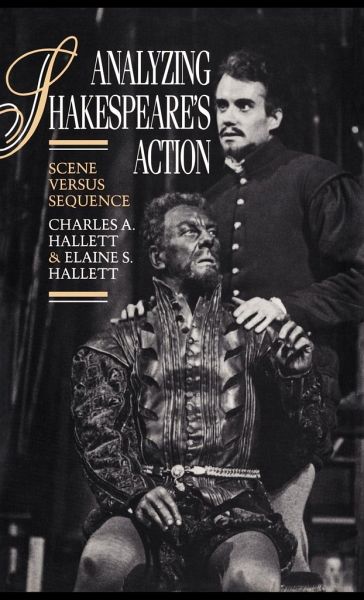
Analyzing Shakespeare's Action
Scene Versus Sequence

PAYBACK Punkte
55 °P sammeln!
In this book, Charles and Elaine Hallett invite the reader to follow the actions of Shakespeare's plays. They show that the conventional division of the plays into scenes does not help the reader or play-goer to discover how the narrative works. They offer instead a division into smaller units which they define as beats, sequences and frames. For both scholar and practitioner, their observations offer new insights about how the building blocks of the plays are deployed. Detailed analysis of the unfolding action reveals that Shakespeare's scenes frequently consist of a series of sequences, each...
In this book, Charles and Elaine Hallett invite the reader to follow the actions of Shakespeare's plays. They show that the conventional division of the plays into scenes does not help the reader or play-goer to discover how the narrative works. They offer instead a division into smaller units which they define as beats, sequences and frames. For both scholar and practitioner, their observations offer new insights about how the building blocks of the plays are deployed. Detailed analysis of the unfolding action reveals that Shakespeare's scenes frequently consist of a series of sequences, each with its own individual climax, and these sequences are regularly built up of a succession of smaller units, or beats. Several sequences usually work together to create a still larger action, or frame. Study of these components yields valuable information about Shakespeare's playwriting techniques, information not readily available elsewhere in critical literature, and of immense value in articulating the dramatic rhythms and structure of Shakespeare's action. This analytical method, while especially tuned to Shakespeare, can also be adapted to other dramatists in varying degrees. The book will be of interest to students and scholars of Shakespeare and theatre studies as well as to actors and directors.
Table of contents:
1. Scene vs. sequence in Shakespeare's plays; 2. The beat defined; 3. Ancillary beats: the interval beat, the interpolated beat, the linking beat; 4. Sequential beats: the introductory beat; 5. Sequential beats: the concluding beat 6. Sequential beats: the intensifying beat; 7. The dramatic question; 8. Observing and meditating sequences; 9. Reporting and interrogating sequences; 10. Persuading sequences; 11. Disputing sequences; 12. Commanding sequences; 13. Sequences combined: the frame; Glossary.
Here the authors invite the reader to follow the actions of Shakespeare's plays. They show that the conventional division of the plays into scenes does no help one to discover how the narrative works; and offer instead a division into smaller units which they define as beats, sequences and frames.
Table of contents:
1. Scene vs. sequence in Shakespeare's plays; 2. The beat defined; 3. Ancillary beats: the interval beat, the interpolated beat, the linking beat; 4. Sequential beats: the introductory beat; 5. Sequential beats: the concluding beat 6. Sequential beats: the intensifying beat; 7. The dramatic question; 8. Observing and meditating sequences; 9. Reporting and interrogating sequences; 10. Persuading sequences; 11. Disputing sequences; 12. Commanding sequences; 13. Sequences combined: the frame; Glossary.
Here the authors invite the reader to follow the actions of Shakespeare's plays. They show that the conventional division of the plays into scenes does no help one to discover how the narrative works; and offer instead a division into smaller units which they define as beats, sequences and frames.




